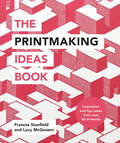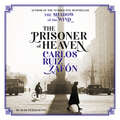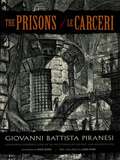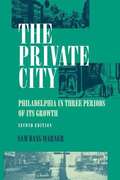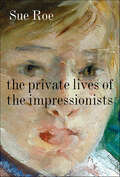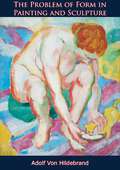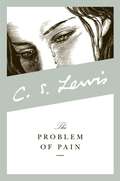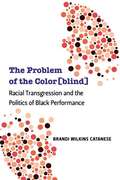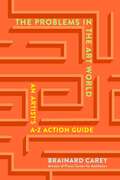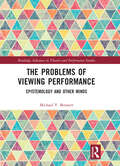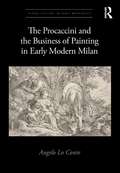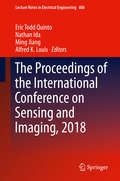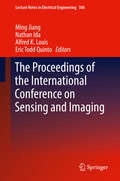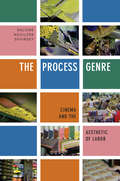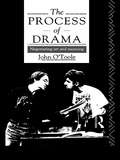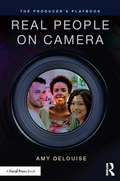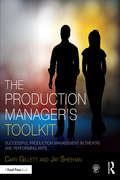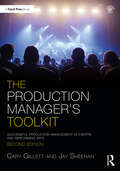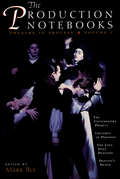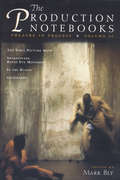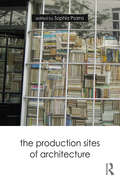- Table View
- List View
The Printmaking Ideas Book
by Frances Stanfield Lucy McGeownFrom traditional methods such as screenprinting, etching and lithography to contemporary techniques such as risography and digital collage, this book is packed with new ideas, methods and tips on every page.Brimming with experimental, arresting and beautiful examples of printmaking from all over the world, it will take your creativity further and awaken new ideas.
The Prisoner of Heaven: The Cemetery of Forgotten Books 3
by Carlos Ruiz ZafonTHE PRISONER OF HEAVEN returns to the world of the Cemetery of Forgotten Books and the Sempere & Sons bookshop.It begins just before Christmas in Barcelona in 1957, one year after Daniel and Bea from THE SHADOW OF THE WIND have married. They now have a son, Julian, and are living with Daniel's father at Sempere & Sons. Fermin still works with them and is busy preparing for his wedding to Bernarda in the New Year. However something appears to be bothering him.Daniel is alone in the shop one morning when a mysterious figure with a pronounced limp enters. He spots one of their most precious volumes that is kept locked in a glass cabinet, a beautiful and unique illustrated edition of THE COUNT OF MONTE CRISTO. Despite the fact that the stranger seems to care little for books, he wants to buy this expensive edition. Then, to Daniel's surprise, the man inscribes the book with the words 'To Fermin Romero de Torres, who came back from the dead and who holds the key to the future'. This visit leads back to a story of imprisonment, betrayal and the return of a deadly rival ...
The Prisoner of Heaven: The Cemetery of Forgotten Books 3
by Carlos Ruiz ZafonTHE PRISONER OF HEAVEN returns to the world of the Cemetery of Forgotten Books and the Sempere & Sons bookshop.It begins just before Christmas in Barcelona in 1957, one year after Daniel and Bea from THE SHADOW OF THE WIND have married. They now have a son, Julian, and are living with Daniel's father at Sempere & Sons. Fermin still works with them and is busy preparing for his wedding to Bernarda in the New Year. However something appears to be bothering him.Daniel is alone in the shop one morning when a mysterious figure with a pronounced limp enters. He spots one of their most precious volumes that is kept locked in a glass cabinet, a beautiful and unique illustrated edition of THE COUNT OF MONTE CRISTO. Despite the fact that the stranger seems to care little for books, he wants to buy this expensive edition. Then, to Daniel's surprise, the man inscribes the book with the words 'To Fermin Romero de Torres, who came back from the dead and who holds the key to the future'. This visit leads back to a story of imprisonment, betrayal and the return of a deadly rival ...Read by Peter Kenny(p) 2012 Orion Publishing Group
The Prisons / Le Carceri
by John Howe Giovanni Battista Piranesi Philip HoferThe timeless Carceri etchings of Piranesi (1720-1778) represent not only spectacular artistic accomplishments but also unforgettable expressions of psychological truths. Combining the influences of Tiepolo, Bibiena, and Rembrandt, these works of architectural fantasy challenge the boundaries of perception, creating a vast system of visual provocation. Innumerable staircases, immense vaults, and other ambiguous structures are compounded with projecting beams, pulleys, rickety catwalks and gangways, dangling ropes and chains, and the occasional shadowy human figure.This full reproduction in book form of The Prisons, made directly from mint copies of original prints, presents both editions of Piranesi's work, with prints on facing pages for convenient comparison. The first edition (circa 1745) ranks among the most rare and valuable print collections in existence and abounds in a multiplicity of perspectives--an innovation that predates Cubism by two centuries. For the second (1761) edition, Piranesi reworked the plates, adding elaborate details that alter some of them almost beyond recognition. It is in the second, more emotionally challenging renditions that his masterful management of light and shadow is most evident. This edition features an informative Introduction by Philip Hofer, in addition to a Preface by John Howe, a conceptual designer on Peter Jackson's Lord of the Rings film trilogy.
The Private City: Philadelphia In Three Periods Of Its Growth
by Sam Bass WarnerThis award-winning book charts the unfolding, from the Revolutionary War to the Great Depression, of the American tradition of city building and city living, using Philadelphia as a resonant example.
The Private Lives of the Impressionists
by Sue RoeThe New York Times–bestselling biography of Manet, Cezanne, Degas, and others—a “revealing group portrait . . . lively, required reading” (People).Though they were often ridiculed or ignored by their contemporaries, their paintings are now revered around the world. Their dazzling works are familiar to even the most casual art lovers—but how well do we know the Impressionists as people? The first book to offer an intimate and lively biography of the world’s most popular group of artists, including Manet, Monet, Pissarro, Cézanne, Renoir, Degas, Sisley, Morisot, and Cassatt.Sue Roe’s Private Lives of the Impressionists, follows an extraordinary group of artists into their Paris studios, down the rural lanes of Montmartre, and into the rowdy riverside bars of a city undergoing monumental change. Vivid and deeply researched, it casts a brilliant light on this unparalleled society of genius colleagues who lived and worked together for twenty years—and transformed the art world with their breathtaking depictions of ordinary life.
The Problem of Form in Painting and Sculpture
by Adolf Von HildebrandAdolf von Hildebrand (6 October 1847 – 18 January 1921) was a German sculptor.Hildebrand was born at Marburg, the son of Marburg economics professor Bruno Hildebrand. He studied at the Academy of Fine Arts Nuremberg, with Kaspar von Zumbusch at the Munich Academy and with Rudolf Siemering in Berlin. From 1873 he lived in Florence in the St Francesco Monastery, a secularized sixteenth-century monastery.A friend of Hans von Marées, he designed the architectural setting for the painter's murals in the library of the German Marine Zoological Institute at Naples (1873). He spent a significant amount of time in Munich after 1889, executing a monumental fountain there, the Wittelsbacher Brunnen. He is known for five monumental urban fountains and for the Bismarck monument in Bremen, unveiled in 1910.Hildebrand worked in a Neo-classical tradition, and set out his artistic theories in his book Das Problem der Form in der Bildenden Kunst ("The Problem of Form in Painting and Sculpture"), published in 1893.He died in Munich in 1921.
The Problem of Pain (C. S. Lewis Signature Classic Ser.)
by C. S. LewisIn The Problem of Pain, C.S. Lewis, one of the most renowned Christian authors and thinkers, examines a universally applicable question within the human condition: "If God is good and all-powerful, why does he allow his creatures to suffer pain?" With his signature wealth of compassion and insight, C.S. Lewis offers answers to these crucial questions and shares his hope and wisdom to help heal a world hungering for a true understanding of human nature.
The Problem of the Color[blind]: Racial Transgression and the Politics of Black Performance
by Catanese Brandi Wilkins"Catanese's beautifully written and cogently argued book addresses one of the most persistent sociopolitical questions in contemporary culture. She suggests that it is performance and the difference it makes that complicates the terms by which we can even understand 'multicultural' and 'colorblind' concepts. A tremendously illuminating study that promises to break new ground in the fields of theatre and performance studies, African American studies, feminist theory, cultural studies, and film and television studies. " ---Daphne Brooks, Princeton University "Adds immeasurably to the ways in which we can understand the contradictory aspects of racial discourse and performance as they have emerged during the last two decades An ambitious, smart, and fascinating book. " ---Jennifer DeVere Brody, Duke University Are we a multicultural nation, or a colorblind one? The Problem of the Color[blind] examines this vexed question in American culture by focusing on black performance in theater, film, and television. The practice of colorblind casting---choosing actors without regard to race---assumes a performing body that is somehow race neutral. But where, exactly, is race neutrality located---in the eyes of the spectator, in the body of the performer, in the medium of the performance? In analyzing and theorizing such questions, Brandi Wilkins Catanese explores a range of engaging and provocative subjects, including the infamous debate between playwright August Wilson and drama critic Robert Brustein, the film career of Denzel Washington, Suzan-Lori Parks's play Venus, the phenomenon of postblackness (as represented in the Studio Museum in Harlem's "Freestyle" exhibition), the performer Ice Cube's transformation from icon of gangsta rap to family movie star, and the controversial reality television series Black. White. Concluding that ideologies of transcendence are ahistorical and therefore unenforceable, Catanese advances the concept of racial transgression---a process of acknowledging rather than ignoring the racialized histories of performance---as her chapters move between readings of dramatic texts, films, popular culture, and debates in critical race theory and the culture wars.
The Problems in the Art World: An Artist's A-Z Action Guide
by Brainard CareyLearn how to navigate the turbulent seas of the art world from acclaimed art advocate Brainard Carey. In this succinct volume, author Brainard Carey, an artist with prestigious exhibitions like the Whitney Biennial under his belt, distills two decades of personal experience and over 1,900 interviews with artists and curators for Yale University Radio exploring the question of how to achieve, manage, and maintain art careers. In The Problems in the Art World: An Artist&’s A-Z Action Guide, Carey directly addresses the following key challenges every artist grapples with at some point: A. The problem of commitment B. The problem of getting recognition C. The problem of a community D. The problem with grants E. The problem with money F. The opportunities problem G. The scam problem H. The social media problem And much more! With a shareable illustrated format for easily taking action, The Problems in the Art World is an A-Z guide on the best paths to take and the best choices to make to survive and thrive in the unpredictable art world.
The Problems of Viewing Performance: Epistemology and Other Minds (Routledge Advances in Theatre & Performance Studies)
by Michael Y. BennettThe Problems of Viewing Performance challenges long-held assumptions by considering the ways in which knowledge is received by more than a single audience member, and breaks new ground by, counterintuitively, claiming that viewing performance is not a shared experience. Given that viewers come to each performance with differing amounts and types of knowledge, they each make different assumptions as to how the performance will unfold. Often modified by other viewers and often after the performance event, knowledge of performance is made more accurate by superimposing the experiences and justified beliefs of multiple viewers. These differences in the viewing experience make knowledge surrounding a performance intersubjective. Ultimately, this book explains the how and the why audience members have different viewing experiences. The Problems of Viewing Performance is important reading for theatre and performance students, scholars and practitioners, as it unpacks the dynamics of spectatorship and explores how audiences work.
The Procaccini and the Business of Painting in Early Modern Milan (Visual Culture in Early Modernity)
by Angelo Lo ConteThe book investigates the lives and careers of the Procaccini brothers: Camillo (1561–1629), Carlo Antonio (1571–1631) and Giulio Cesare (1574–1625), the most important family of painters working in northern Italy at the start of the seventeenth century. The Procaccinis' work is here analysed by interconnecting their individual stories and understanding their success as the combination of mutual artistic choices, a high level of specialization and precise business organization. The book looks at this family of painters as entrepreneurs, emphasizing their conscious response to the requests of public and private patrons, as well as their ability to balance instances of originality and imitation in an era characterized by a wide range of artistic opportunities, including religious commissions, national and international patronage and multifaceted markets. This book will be of interest to scholars studying art history, early modern studies, the art market, Italian studies and Italian history.
The Proceedings of the International Conference on Sensing and Imaging, 2018 (Lecture Notes in Electrical Engineering #606)
by Ming Jiang Nathan Ida Alfred K. Louis Eric Todd QuintoThis book proceedings collects a number of papers presented at the International Conference on Sensing and Imaging, which was held at Guangxi University of Science and Technology from October 15-18, 2018. Sensing and imaging is an interdisciplinary field covering a variety of sciences and techniques such as optics, electricity, magnetism, heat, sound, and computing technologies. The field has diverse applications of interest such as image processing techniques.The results in the book bridge the gap between theory and applications, translating techniques into better products. The text will appeal to students, professionals and researchers alike.
The Proceedings of the International Conference on Sensing and Imaging: Chengdu University Of Information Technology, Chengdu, Sichuan, China, On June 5-7 2017 (Lecture Notes in Electrical Engineering #506)
by Ming Jiang Nathan Ida Alfred K. Louis Eric Todd QuintoThis book collects a number of papers presented at the International Conference on Sensing and Imaging, which was held at Chengdu University of Information Technology on June 5-7, 2017. Sensing and imaging is an interdisciplinary field covering a variety of sciences and techniques such as optics, electricity, magnetism, heat, sound, mathematics, and computing technology. The field has diverse applications of interest such as sensing techniques, imaging, and image processing techniques. This book will appeal to professionals and researchers within the field.
The Process Genre: Cinema and the Aesthetic of Labor
by Salomé Aguilera SkvirskyFrom IKEA assembly guides and “hands and pans” cooking videos on social media to Mister Rogers's classic factory tours, representations of the step-by-step fabrication of objects and food are ubiquitous in popular media. In The Process Genre Salomé Aguilera Skvirsky introduces and theorizes the process genre—a heretofore unacknowledged and untheorized transmedial genre characterized by its representation of chronologically ordered steps in which some form of labor results in a finished product. Originating in the fifteenth century with machine drawings, and now including everything from cookbooks to instructional videos and art cinema, the process genre achieves its most powerful affective and ideological results in film. By visualizing technique and absorbing viewers into the actions of social actors and machines, industrial, educational, ethnographic, and other process films stake out diverse ideological positions on the meaning of labor and on a society's level of technological development. In systematically theorizing a genre familiar to anyone with access to a screen, Skvirsky opens up new possibilities for film theory.
The Process of Drama: Negotiating Art and Meaning
by John O'TooleThe Process of Drama provides an original and invaluable model of the elements of drama in context, and defines how these are negotiated to produce dramatic art. John O'Toole takes the reader through a lively, fascinating account of the relationships between the playwright, the elements of dramatic art, and the other artists involved in this most interactive of creative processes. In doing so he demonstrates - with clarity and wit - how dramatic meaning emerges; how the dramatic event is constructed. Areas covered include: roles and relationships the drama space language and movement tension and the audience gesture and movement This is an essential book for every student of drama who wants to understand how the theatrical art form operates
The Process: A New Foundation in Art, Design
by Richard Wilde Judith WildeThe Process: A New Foundation in Art and Design is a compendium of 13 experimental projects designed to teach conceptual thinking and problem solving to art and design students.The projects, created by Judith Wilde and Richard Wilde, focus on developing formal excellence and a strong sense of aesthetics, along with the ability to generate new ideas. Each project is illustrated with multiple visual solutions, provided to inspire creativity and illustrate that there can be multiple solutions to a single problem.
The Process: A New Foundation in Art, Design
by Richard WildeThe Process: A New Foundation in Art and Design is a compendium of 13 experimental projects designed to teach conceptual thinking and problem solving to art and design students.The projects, created by Judith Wilde and Richard Wilde, focus on developing formal excellence and a strong sense of aesthetics, along with the ability to generate new ideas. Each project is illustrated with multiple visual solutions, provided to inspire creativity and illustrate that there can be multiple solutions to a single problem.
The Producer's Business Handbook: The Roadmap for the Balanced Film Producer (American Film Market Presents)
by Anne Marie Gillen John J. Lee, Jr.Gain a comprehensive understanding of the business of entertainment and learn to successfully engage in all aspects of global production with the revised and updated 4th edition of The Producer's Business Handbook. Learn how to cultivate relationships with key industry players including domestic and foreign studios, agencies, attorneys, talent, completion guarantors, banks, and private investors. This edition has been updated to include the latest opportunities presented by changing technology and their impact on the producer’s ability to brand, monetize, finance and globally release content. Also included is new information on audience, earning, distribution and funding opportunities created by the explosive growth of VR, AR, 360 and gaming, as well as the rapid conversion to OTT. Additional features include: Completely updated production financing worksheets – an essential tool for producers; Expanded information for low-budget independent producers, internationally-based producers, producers using government funding, and film school students alike; Coverage of China’s changing entertainment landscape, including their entertainment consumption, their commitment to produce content for the big global territories, and more; New, full-color illustrations and graphics that provide a visual representation of complex topics.
The Producer's Playbook: Directing and Working with Non-Actors (The Producer's Playbook)
by Amy DeLouiseProducer’s Playbook: Real People on Camera is a no-nonsense guide for producers looking to get the best performances from "real people" to tell powerful stories on video. Director/producer Amy DeLouise brings years of experience to this resource for creating the best on-screen impact with non-actors for interviews, re-enactments, documentary and direct-to-camera messages. With useful case studies and tips on everything from managing locations and budgeting to strategies for managing crews and the expectations of executive producers and clients, this is an invaluable resource for professionals working in reality TV, documentary, corporate video, and more. Ample case studies with perspectives from industry professionals interviewed by the author, as well as her own plentiful stories from the field Tips are featured in sidebars throughout the text, so that readers can see how the information applies to real situations Full-color photographs allow readers to visualize real world production situations The appendix includes useful templates and checklists for working producers
The Production Manager's Toolkit: Successful Production Management in Theatre and Performing Arts (The Focal Press Toolkit Series)
by Cary Gillett Jay Sheehan"Our theater world is so much better with this book in it, and even better with Cary and Jay at the helm." –David Stewart, Director of Production for the Guthrie Theater The Production Manager’s Toolkit is a comprehensive introduction to a career in theatrical and special event production for new and aspiring professionals, given by expert voices in the field. The book discusses management techniques, communication skills, and relationship building tactics to create effective and successful production managers. With a focus on management theory, advice from top production managers provide insights into budgeting, scheduling, meetings, hiring, maintaining safety, and more. Through interviews and case studies, the history and techniques of production management are explored throughout a variety of entertainment venues: theatre, dance, opera, and special events. The book includes references, tools, templates, and checklists; and a companion website contains downloadable paperwork and links to other useful resources such as unions, venues, and vendors.
The Production Manager's Toolkit: Successful Production Management in Theatre and Performing Arts (The Focal Press Toolkit Series)
by Cary Gillett Jay SheehanThe Production Manager’s Toolkit Second Edition offers an up-to-date, comprehensive introduction to a theatrical and special event production career for new and aspiring professionals, given by expert voices in the field. The book discusses management techniques, communication skills, and relationship building tactics to become effective and successful production managers. With a focus on management theory, top production managers provide insights into budgeting, scheduling, meetings, hiring, maintaining safety, and more. Through interviews and case studies, production management techniques are explored throughout various entertainment genres including theatre, dance, opera, music, and special events. The second edition includes all new case studies, new chapters, and updated content throughout, showcasing a continued progressive approach to the job and the field. Filled with references, tools, templates, and checklists, The Production Manager’s Toolkit is an invaluable resource for students of Production Management, Events Management, and Stage Management courses, as well as new and aspiring professionals. The book includes access to a companion website featuring downloadable paperwork and links to other useful resources such as unions, venues, and vendors. (www.routledge.com/cw/gillett)
The Production Notebooks
by Mark BlyFirst in a series of casebooks exploring theatrical pieces from writing and design through production. Includes: Ntozake Shange's The Love Space Demands, Crossroads Theatre Co., New Brunswick, NJ; Danton's Death by Buchner, Alley Theatre, Houston; The Clytemnestra Project, based on the works of Aeschylus, Sophocles, and Euripides, Guthrie Theatre, Minneapolis; and Children of Paradise, Theatre de la Jeune Lune, Minneapolis.
The Production Notebooks, Volume 2
by Mark BlyThe second volume in the series provides an inside view of the creative process involved in the creation of 4 major theatrical productions. Each notebook offers in diary form comprehensive histories of major artistic elements that are the center of the creative process. This volume includes: In the Blood by Suzan-Lori Parks (The Joseph Papp Public Theatre/New York Shakespeare Festival); The First Picture Show by David and Ain Gordon (Mark Taper Forum and American Conservatory Theatre), The Geography Project by Ralph Lemon (Yale Repertory Theatre) and Shakespeare Rapid Eye Movement, directed by Robert Lepage (Bayerisches Staatsschauspiel-Munich). Each notebook is profusely illustrated with production shots and/or set and costume renderings.Mark Bly is the Associate Artistic Director of the Yale Repertory Theatre.
The Production Sites of Architecture
by Sophia PsarraThe Production Sites of Architecture examines the intimate link between material sites and meaning. It explores questions such as: how do spatial configurations produce meaning? What are alternative modes of knowledge production? How do these change our understanding of architectural knowledge? Featuring essays from an international range of scholars, the book accepts that everything about the production of architecture has social significance. It focuses on two areas: firstly, relationships of spatial configuration, form, order and classification; secondly, the interaction of architecture and these notions with other areas of knowledge, such as literature, inscriptions, interpretations, and theories of classification, ordering and invention. Moving beyond perspectives which divide architecture into either an aesthetic or practical art, the authors show how buildings are informed by intersections between site and content, space and idea, thought and materiality, architecture and imagination. Presenting illustrated case studies of works by architects and artists including Amale Andraos, Dan Wood, OMA, Koen Deprez and John Soane, The Production Sites of Architecture makes a major contribution to our understanding of architectural theory.
